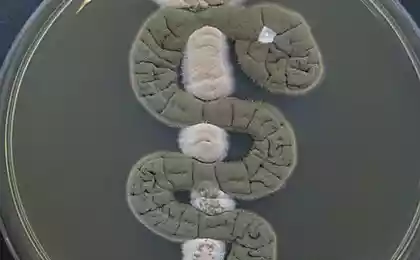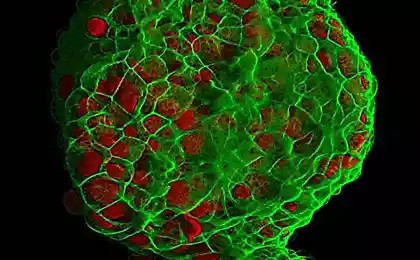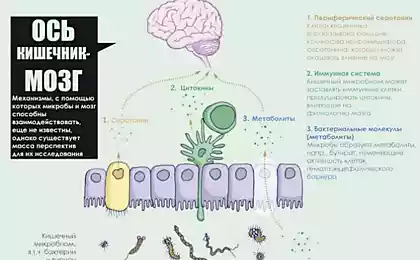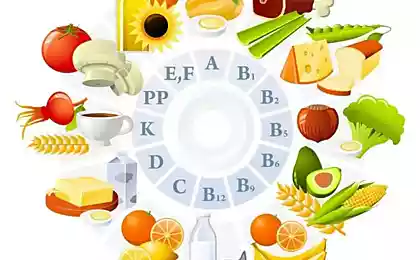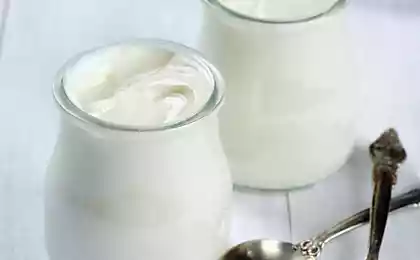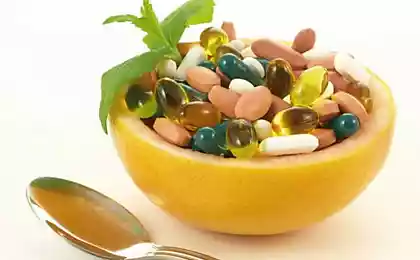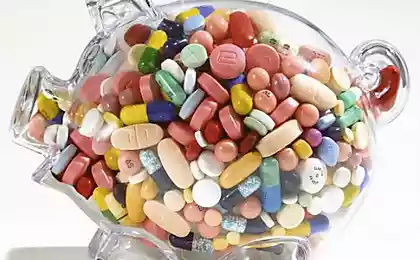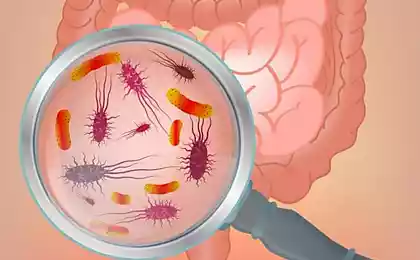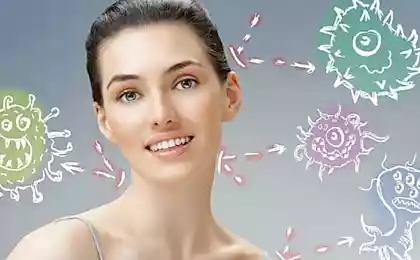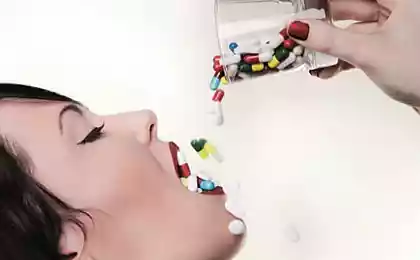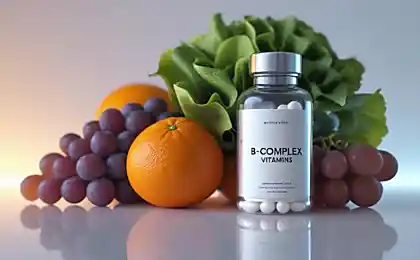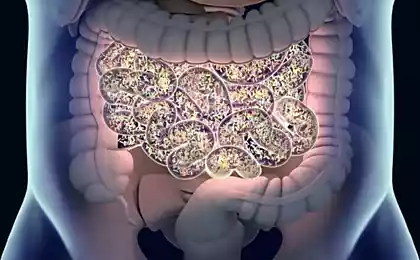886
Why probiotics are more important than vitamins
What is pre - and probiotics, about which so many speak? Can I use them to cure any diseases of the gastrointestinal tract, if they have contraindications? Passion.ru asked these and many other questions concerning pre - and probiotics, doctor.
Did you know that 2-3 kg of weight healthy adult make up the inhabitants of his intestines — microorganisms? This mass cannot be ignored. Our "rich inner world" need to feed, water and sometimes a treat!

In conditions of malnutrition, stress, a sedentary lifestyle inhabitants of our intestines is often required artificial support. For this invented pre - and probiotics.
Probiotics contain microorganisms from among the natural inhabitants of the intestine (symbiotic bacteria) and their metabolic products. Taking drugs and dietary supplements from this group, we seek to colonize the gut the "right tenants".
Prebiotics do not contain the microorganisms themselves, but create good conditions for their life. Typically, these medications are composed of oligosaccharides, enzymes, acids and other substances used as food by intestinal microflora or have a stimulating effect on its growth and development.
Classification of pre - and probiotics Probiotics are produced in four basic forms:
The first preparations of probiotics appeared in Russia in the middle of the last century, but the highest prevalence was in the last 10-15 years.
In the experiment, these drugs have shown remarkable properties, they had virtually no side effects and contraindications and promised to be a panacea for many diseases. What is not a magic elixir? Drink and forget about health problems!
In practice, however, the money spent on the treatment of pre - and probiotics, are often thrown to the wind. The effect of treatment does not always meet the doctor and the patient, and lately there are increasing reports about the negative impact of probiotics on health.
Why do we need pre - and probiotics? And when their action does not meet the stated in the instructions?
What to treat pre - and probiotics? As stated by the manufacturers, pre - and probiotics are widely used for rehabilitation and treatment of the body.
Unicellular "antibiotics". Bacteria probiotics into the intestine, immediately start a war against harmful (pathogenic) microbes for the free living space. They densely populate the intestinal wall without leaving any empty places for pathogens.
Olivas in the intestine, beneficial bacteria change the pH to the acid side. And the causative agents of intestinal infections "sour life" 't stand and are killed in such circumstances.
Finally, some bacteria have learned to synthesize these antibiotics. However, are these antibiotics "in the mind": only the harmful microorganisms.
Because of these properties, pre - and probiotics used during intestinal infections, including viral nature. Solve problems with digestion. Pre - and probiotics stop the processes of fermentation and putrefaction in the intestine involved in the digestion of food, absorb its surface gases, thereby reducing bloating and improving digestion.
Probiotic bacteria secrete a number of substances, strengthening and healing the intestinal wall in various inflammatory processes.
So used in violation of stool (diarrhea and constipation), bloating, rumbling and abdominal pain. The second liver. Beneficial bacteria-probiotics are able to neutralize many substances, ranging from toxic products of metabolism and ending with antibiotics, heavy metals and carcinogens (substances causing cancer).
Pre - and probiotics is able to absorb its surface toxins, "toxins" and even viruses. Standing out with the intestinal contents out, they cleanse the body of "debris", showing the properties of adsorbents and detoxifiers. Strengthen the immune system. Probiotics in the intestinal microflora have powerful immunomodulating effects. They strengthen our protection against a variety of diseases: colds, herpes and even cancer!
Probiotics can help Allergy and autoimmune diseases (when the Allergy develops on its own cells and organs).
It was found that the centenarians of the Caucasus over the age of 95 years, the composition of the intestinal microflora is very similar to child: main link are lactic acid bacteria and bifidobacteria. They have a number of these bacteria decreases with age, and has a clear link with life expectancy. Perhaps deciphering the nature of this relationship will help mankind to find the secret of eternal youth. When probiotics are "down"
Probiotics can not cope with their responsibilities, when we are trying to get rid of the symptom (unstable stool, bloating, abdominal pain, etc.) without addressing in advance the cause:
In all these cases, in the intestine long-term conditions are supported, suitable for normal existence of beneficial bacteria. Therefore, probiotics can have a temporary effect, but never take hold for long.
Initially it is necessary to achieve remission of chronic diseases (especially gastrointestinal tract), get rid of foci of infection, restore hormonal balance and correct nutrition etc.
Probiotics, once in the intestine, rejected by the indigenous microflora as a foreign organ transplant, despite the biological relationship.
This is because each of us has a unique "own" the community of intestinal microbes, which closely interact with each other and even exchange genetic information.
Therefore, even the best probiotics with a "laboratory" bacteria do not always survive in natural conditions.
In this regard were the development of the creation of probiotics "on order" from their own human flora. The essence of development consists in the fact that the sample of the normal intestinal microflora can be frozen in liquid nitrogen, and then if you want to use as the basis for the probiotic.
Imagine: before the operation, long-term use of medications, pregnancy, travel, or other events that could trigger the development of dysbiosis, it will be possible to prepare such a sample in the Cryobank, and then, if necessary, to use it to restore microflora. Two strategies All existing probiotics can be divided into two groups, fundamentally different mechanism of action.
I. the Most commonly available probiotics are products containing the natural microflora of the human intestine: live if-, lacto-and bifidobacteria ("Bifidumbacterin", "Lactobacterin", "Biobacton", "Lactobacilli", "Nutropin", "Colibacterin", "Mutaflor").
They are used in medicine for more than 80 years and is well studied.
Advantages
Soft physiological effect, and the almost complete absence of contraindications and side effects.
Disadvantages
The therapeutic effect of these probiotics is decreasing every year, to provide a therapeutic effect they must travel a difficult path "habitation" in the gut. In addition, lacto-, coli - and bifidobacteria were weak opponents for intestinal infections pathogens and pathogenic fungi.
Therefore, scientists developed a new group of probiotics.
II. Spore-forming antagonist ("Enteral", "Baktisubtil", "Sporobakterin", "Bactisporin", "Biosporin"). The composition of spore-forming bacteria of probiotics are microbes that are not part of the normal microflora: Bacillus, Clostridium, yeast, etc. On these drugs, hopes are high, but their use is limited.
Advantages
They contain live bacteria and spores — the resting, inactive form. Therefore, these drugs can long be stored. Disputes during the passage through the stomach less destroyed by the digestive juices and to a greater extent reaches the intestine than live bacteria.
The action of spore-forming probiotics starts almost immediately after the reception for 10-15 minutes, allowing them to be used as "first aid" when frustration of a chair, acute infections.
They are more efficient in destroying disease-causing microbes and fungi, at the same time stimulating the growth of normal microflora. These drugs have good healing and anti-allergic action.
Spore forming antagonists do not survive in the intestine and after 1-1,5 months are removed from the body. But by this time have time to show all the therapeutic properties.
As a result, the intestines are created the best conditions for natural recovery of microflora. In addition, as a foreign body, they exert a powerful stimulating effect on the immune system.
Disadvantages
In the family of spore-forming bacteria are extremely aggressive counterparts, agents of such dangerous diseases as anthrax, botulism, gas gangrene, tetanus, etc.
Even among the innocent members of the species there are strains that produce strong toxins. And to distinguish these bacteria from each other under the force of each laboratory.
Therefore, probiotics from this group should be subject to very strict control, which is not always implemented in practice. It is especially difficult to control the production of food and biologically active additives containing spore-forming bacteria.
While currently there is no uniform international standards for the production of spore-forming probiotics, even the names of the bacteria, there is confusion.
Spore-forming probiotics have certain contraindications: immunodeficiency (including AIDS), radiation therapy, and status after organ transplantation.
That the treatment was effective and harmless, to resort to the use of probiotics, especially spore-forming, only with a doctor's prescription. Should be treated very carefully to the use of sporeforming probiotics in the composition of biologically active additives and food products.
Fortified foods: how to choose? Enriched products are a common food, which in the production of further added prebiotics, probiotics, vitamins, minerals, proteins, etc.
The additive content in the fortified product should be 10-50% of the daily value.
The range of such products is large enough. These include not only yogurt, but also bakery products, cereals, baby foods and even sausages.
In accordance with existing regulations on the packaging of the product containing probiotics, in addition to date of manufacture and shelf life must be specified: the exact composition indicating the number of bacteria, their name, contraindications to possible side effects and phone numbers to report them.
Pay particular attention to the shelf life of the product. Yogurt containing live culture fermented milk may be stored no more than 3-5 days. And the concentration of microbes throughout the shelf-life is constantly changing. So they often specify the number of bacteria at end of shelf life.
Fresh yogurt (the first day) has a laxative effect, strong(3-day) — on the contrary, reinforces. This is especially important if you choose yogurt for your baby.
What is the SOMETHING? Precise definition — Kolonialismus Unit. That is, the microbial particle, capable of reproduction. The more SOMETHING in a product, the more it affects our health. For example, the yoghurt should contain at least 107 CFU in 1 g of product.
Many products have prebiotic properties. It is primarily whole milk powder, milk products, vegetables, fruits, and grains. The traditional source of prebiotics are considered to be the bran (the best properties are oat and wheat).
Some scientists believe that out of all the food that enters to our body, 70% should reach the large intestine almost unchanged and only there to exert their effects. This means that more than two-thirds of our diet should consist of coarse vegetable food which is poorly digested in the stomach, but it provides essential prebiotic effect on the intestinal microflora.
If filling the trolley in the supermarket, we will not think about fatigue, a forthcoming report or the home, and the quality and benefit of the products that are going to buy, many health problems can be avoided.
It turns out that the admission of pre - and probiotics may solve some external problems: acne, dandruff, and even baldness. After all, their germs on the skin. It is proved that the composition of intestinal microflora and microbes that live on the scalp and face, depend on each other.
Currently, pre - and probiotics are used effectively to treat skin diseases.
In recent years, many cosmetic companies have developed cosmetics that consists of probiotics. Among the claimed properties, not only the solution to the problems of acne, but also slowing aging, anti-allergic and anti-inflammatory action.
The effectiveness of "live" cosmetics yet to be tested. But eating a Cup of yogurt a day (with a shelf life of not more than 10 days) and replacing part of the bakery products in the diet of wheat bran, you definitely will notice a positive result.
Author: Natalia Dolgopolova
P. S. And remember, only by changing their consumption — together we change the world! ©
Join us in Facebook , Vkontakte, Odnoklassniki
Source: www.7ya.ru/article/Probiotiki-modnyj-mif-ili-klyuch-k-zdorovyu/
Did you know that 2-3 kg of weight healthy adult make up the inhabitants of his intestines — microorganisms? This mass cannot be ignored. Our "rich inner world" need to feed, water and sometimes a treat!

In conditions of malnutrition, stress, a sedentary lifestyle inhabitants of our intestines is often required artificial support. For this invented pre - and probiotics.
Probiotics contain microorganisms from among the natural inhabitants of the intestine (symbiotic bacteria) and their metabolic products. Taking drugs and dietary supplements from this group, we seek to colonize the gut the "right tenants".
Prebiotics do not contain the microorganisms themselves, but create good conditions for their life. Typically, these medications are composed of oligosaccharides, enzymes, acids and other substances used as food by intestinal microflora or have a stimulating effect on its growth and development.
Classification of pre - and probiotics Probiotics are produced in four basic forms:
- monocomponent probiotics contain only one kind of microorganisms.
For example, "Bifidumbacterin" — bifidobacteria, "Lactobacterin" — lactobacilli, "Colibacterin" colibacterin etc. - polycomponent probiotics include several species of microorganisms.
For example, "Lifelong", "Bificol", "Ocarinas", "Atsilakt", "Linex", etc. - combined probiotics (synbiotics) — "two in one" contain probiotics and prebiotics.
For example, "Bifidumbacterin Forte", "Sifilis", "Bifiform", "Battistini", "Primadophilus", "Prabakaran", etc. - recombinant (genetically engineered) probiotics in the manufacture of such preparations, the bacteria are useful genes, bringing new properties to the colony.
For example, the drug "Subalin" contains microbes that are able to synthesize interferon.
To drug prebiotics are "Duphalac (Lactulose"), "Calcium Pantothenate", "Lysozyme", etc.
The first preparations of probiotics appeared in Russia in the middle of the last century, but the highest prevalence was in the last 10-15 years.
In the experiment, these drugs have shown remarkable properties, they had virtually no side effects and contraindications and promised to be a panacea for many diseases. What is not a magic elixir? Drink and forget about health problems!
In practice, however, the money spent on the treatment of pre - and probiotics, are often thrown to the wind. The effect of treatment does not always meet the doctor and the patient, and lately there are increasing reports about the negative impact of probiotics on health.
Why do we need pre - and probiotics? And when their action does not meet the stated in the instructions?
What to treat pre - and probiotics? As stated by the manufacturers, pre - and probiotics are widely used for rehabilitation and treatment of the body.
Unicellular "antibiotics". Bacteria probiotics into the intestine, immediately start a war against harmful (pathogenic) microbes for the free living space. They densely populate the intestinal wall without leaving any empty places for pathogens.
Olivas in the intestine, beneficial bacteria change the pH to the acid side. And the causative agents of intestinal infections "sour life" 't stand and are killed in such circumstances.
Finally, some bacteria have learned to synthesize these antibiotics. However, are these antibiotics "in the mind": only the harmful microorganisms.
Because of these properties, pre - and probiotics used during intestinal infections, including viral nature. Solve problems with digestion. Pre - and probiotics stop the processes of fermentation and putrefaction in the intestine involved in the digestion of food, absorb its surface gases, thereby reducing bloating and improving digestion.
Probiotic bacteria secrete a number of substances, strengthening and healing the intestinal wall in various inflammatory processes.
So used in violation of stool (diarrhea and constipation), bloating, rumbling and abdominal pain. The second liver. Beneficial bacteria-probiotics are able to neutralize many substances, ranging from toxic products of metabolism and ending with antibiotics, heavy metals and carcinogens (substances causing cancer).
Pre - and probiotics is able to absorb its surface toxins, "toxins" and even viruses. Standing out with the intestinal contents out, they cleanse the body of "debris", showing the properties of adsorbents and detoxifiers. Strengthen the immune system. Probiotics in the intestinal microflora have powerful immunomodulating effects. They strengthen our protection against a variety of diseases: colds, herpes and even cancer!
Probiotics can help Allergy and autoimmune diseases (when the Allergy develops on its own cells and organs).
It was found that the centenarians of the Caucasus over the age of 95 years, the composition of the intestinal microflora is very similar to child: main link are lactic acid bacteria and bifidobacteria. They have a number of these bacteria decreases with age, and has a clear link with life expectancy. Perhaps deciphering the nature of this relationship will help mankind to find the secret of eternal youth. When probiotics are "down"
Probiotics can not cope with their responsibilities, when we are trying to get rid of the symptom (unstable stool, bloating, abdominal pain, etc.) without addressing in advance the cause:
- chronic illnesses and infections, hormonal disorders;
- for a long period of supply deficit (insufficient dietary intake of fiber, dairy products, and mono-component diets, starvation);
- long-term use of medication (antibiotics (more than 7-14 days), laxatives, antisecretory drugs, corticosteroids, oral contraceptives), as well as preservatives, dyes, flavor enhancers;
- in immunodeficiency.
In all these cases, in the intestine long-term conditions are supported, suitable for normal existence of beneficial bacteria. Therefore, probiotics can have a temporary effect, but never take hold for long.
Initially it is necessary to achieve remission of chronic diseases (especially gastrointestinal tract), get rid of foci of infection, restore hormonal balance and correct nutrition etc.
Probiotics, once in the intestine, rejected by the indigenous microflora as a foreign organ transplant, despite the biological relationship.
This is because each of us has a unique "own" the community of intestinal microbes, which closely interact with each other and even exchange genetic information.
Therefore, even the best probiotics with a "laboratory" bacteria do not always survive in natural conditions.
In this regard were the development of the creation of probiotics "on order" from their own human flora. The essence of development consists in the fact that the sample of the normal intestinal microflora can be frozen in liquid nitrogen, and then if you want to use as the basis for the probiotic.
Imagine: before the operation, long-term use of medications, pregnancy, travel, or other events that could trigger the development of dysbiosis, it will be possible to prepare such a sample in the Cryobank, and then, if necessary, to use it to restore microflora. Two strategies All existing probiotics can be divided into two groups, fundamentally different mechanism of action.
I. the Most commonly available probiotics are products containing the natural microflora of the human intestine: live if-, lacto-and bifidobacteria ("Bifidumbacterin", "Lactobacterin", "Biobacton", "Lactobacilli", "Nutropin", "Colibacterin", "Mutaflor").
They are used in medicine for more than 80 years and is well studied.
Advantages
Soft physiological effect, and the almost complete absence of contraindications and side effects.
Disadvantages
The therapeutic effect of these probiotics is decreasing every year, to provide a therapeutic effect they must travel a difficult path "habitation" in the gut. In addition, lacto-, coli - and bifidobacteria were weak opponents for intestinal infections pathogens and pathogenic fungi.
Therefore, scientists developed a new group of probiotics.
II. Spore-forming antagonist ("Enteral", "Baktisubtil", "Sporobakterin", "Bactisporin", "Biosporin"). The composition of spore-forming bacteria of probiotics are microbes that are not part of the normal microflora: Bacillus, Clostridium, yeast, etc. On these drugs, hopes are high, but their use is limited.
Advantages
They contain live bacteria and spores — the resting, inactive form. Therefore, these drugs can long be stored. Disputes during the passage through the stomach less destroyed by the digestive juices and to a greater extent reaches the intestine than live bacteria.
The action of spore-forming probiotics starts almost immediately after the reception for 10-15 minutes, allowing them to be used as "first aid" when frustration of a chair, acute infections.
They are more efficient in destroying disease-causing microbes and fungi, at the same time stimulating the growth of normal microflora. These drugs have good healing and anti-allergic action.
Spore forming antagonists do not survive in the intestine and after 1-1,5 months are removed from the body. But by this time have time to show all the therapeutic properties.
As a result, the intestines are created the best conditions for natural recovery of microflora. In addition, as a foreign body, they exert a powerful stimulating effect on the immune system.
Disadvantages
In the family of spore-forming bacteria are extremely aggressive counterparts, agents of such dangerous diseases as anthrax, botulism, gas gangrene, tetanus, etc.
Even among the innocent members of the species there are strains that produce strong toxins. And to distinguish these bacteria from each other under the force of each laboratory.
Therefore, probiotics from this group should be subject to very strict control, which is not always implemented in practice. It is especially difficult to control the production of food and biologically active additives containing spore-forming bacteria.
While currently there is no uniform international standards for the production of spore-forming probiotics, even the names of the bacteria, there is confusion.
Spore-forming probiotics have certain contraindications: immunodeficiency (including AIDS), radiation therapy, and status after organ transplantation.
That the treatment was effective and harmless, to resort to the use of probiotics, especially spore-forming, only with a doctor's prescription. Should be treated very carefully to the use of sporeforming probiotics in the composition of biologically active additives and food products.
Fortified foods: how to choose? Enriched products are a common food, which in the production of further added prebiotics, probiotics, vitamins, minerals, proteins, etc.
The additive content in the fortified product should be 10-50% of the daily value.
The range of such products is large enough. These include not only yogurt, but also bakery products, cereals, baby foods and even sausages.
In accordance with existing regulations on the packaging of the product containing probiotics, in addition to date of manufacture and shelf life must be specified: the exact composition indicating the number of bacteria, their name, contraindications to possible side effects and phone numbers to report them.
Pay particular attention to the shelf life of the product. Yogurt containing live culture fermented milk may be stored no more than 3-5 days. And the concentration of microbes throughout the shelf-life is constantly changing. So they often specify the number of bacteria at end of shelf life.
Fresh yogurt (the first day) has a laxative effect, strong(3-day) — on the contrary, reinforces. This is especially important if you choose yogurt for your baby.
What is the SOMETHING? Precise definition — Kolonialismus Unit. That is, the microbial particle, capable of reproduction. The more SOMETHING in a product, the more it affects our health. For example, the yoghurt should contain at least 107 CFU in 1 g of product.
Many products have prebiotic properties. It is primarily whole milk powder, milk products, vegetables, fruits, and grains. The traditional source of prebiotics are considered to be the bran (the best properties are oat and wheat).
Some scientists believe that out of all the food that enters to our body, 70% should reach the large intestine almost unchanged and only there to exert their effects. This means that more than two-thirds of our diet should consist of coarse vegetable food which is poorly digested in the stomach, but it provides essential prebiotic effect on the intestinal microflora.
If filling the trolley in the supermarket, we will not think about fatigue, a forthcoming report or the home, and the quality and benefit of the products that are going to buy, many health problems can be avoided.
It turns out that the admission of pre - and probiotics may solve some external problems: acne, dandruff, and even baldness. After all, their germs on the skin. It is proved that the composition of intestinal microflora and microbes that live on the scalp and face, depend on each other.
Currently, pre - and probiotics are used effectively to treat skin diseases.
In recent years, many cosmetic companies have developed cosmetics that consists of probiotics. Among the claimed properties, not only the solution to the problems of acne, but also slowing aging, anti-allergic and anti-inflammatory action.
The effectiveness of "live" cosmetics yet to be tested. But eating a Cup of yogurt a day (with a shelf life of not more than 10 days) and replacing part of the bakery products in the diet of wheat bran, you definitely will notice a positive result.
Author: Natalia Dolgopolova
P. S. And remember, only by changing their consumption — together we change the world! ©
Join us in Facebook , Vkontakte, Odnoklassniki
Source: www.7ya.ru/article/Probiotiki-modnyj-mif-ili-klyuch-k-zdorovyu/
Michael Litvak: touchy man, it is better not to communicate!
Valery Panyushkin: 5 rules for parents against burnout
